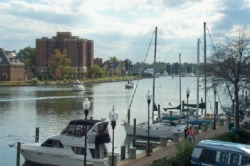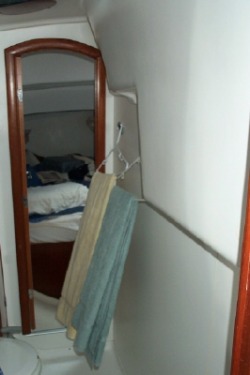
Orion sits at the Hampton Public Pier
Another year older
Cathy’s birthday was supposed to be the day we were to start our trip down the bay to the Intra-Coastal Waterway (ICW), but the weather didn’t cooperate. It was a rainy, cold day, so we instead celebrated by installing her birthday gift from David – a new JVC radio/CD unit to replace our existing one. (The unit being replaced kept refusing to play any of Cathy’s CD’s, spitting them out as soon as they were inserted. It was hard not to take this personally as criticism of her taste in music. A calmer assessment revealed that the problem was more likely moisture in the circuitry, which could be resolved by simply using the unit for a period of time. This meant that we had to listen to the radio. With Solomons’ poor radio reception, that meant listening to WKIK Country, not the first choice of music options for either of us. We listened so long that Cathy was learning the words to the songs, but still the CD’s were being unceremoniously rejected. So the new player was a welcome gift and the old was gleefully tossed.) We finished the evening with a nice dinner at a nearby seafood restaurant, and then said goodbye to Chris and Margaret one more time, whom we hoped to see again soon after they started their trip down the ICW in a couple of weeks.
Into the Fog
We had a long trip ahead on our first day, since the nearest harbor south of Solomons was over 50 nautical miles away – a long trip at 6 knots. And we didn’t want to be arriving at or near dark. With the shorter fall days, this meant we had to leave before sunrise. We pulled out of Solomons in a foggy darkness (could this be a metaphor?) as we headed south on the first day of our southern migration. Relying heavily on our chartplotter’s many tracks in and out of Solomons and the Patuxent River, we crept out of our slip at Hospitality Harbor. Visibility was limited to half a mile by the fog, even after sunrise, which made for an eerie departure as we closely watched our track and squinted into the distance to ensure we could see any vessels (or other objects) ahead of us. Just after we rounded Drum Point into the bay, the fog lifted and we could see to the horizon. Whew!
With little wind, there would be no sailing today. However, it turned out to be a great opportunity to try out our new autopilot on the long, straight run. David started by choosing a bearing and set the autopilot to follow it. It worked like a charm. Then, he tried having it follow a route to a waypoint, which also worked great. (Except, of course for the time that Cathy turned off the instruments accidentally, just as we approached a waypoint. Ooops. Sorry about that.)
As the trip progressed, we were averaging better than 6 knots, almost 6.5, so we decided to push further south to Fishing Bay on the Piankatank River near Deltaville. We made this easily by 4:30 and set our anchor again for the first time in 2 months with little trouble. The number of boats anchored around us gave us our first indication of the herd we would be following south.
We planned to head on to Hampton the next day, weather-permitting. The next morning had predictions of fog again, but it was supposed to lift by 8 or 9am. We decided to get up, check the visibility and decide when to leave. At 7am, you couldn’t see the nearest boats at anchor. By 8am, it had lifted enough that we could see farther boats and just to shore. We decided to once again head out following our track, assuming the fog would lift before we cleared the Piankatank.
Wrong.
The fog was so dense we couldn’t see the navigation marks only 1/10th of a mile away. We started sounding our horn to ensure other boats could hear us. Of course, who else was crazy enough to be out in this soup? Luckily, we encountered no one else. Nine o’clock came and went. Then ten o’clock. It was still dense fog. By 10:30, it finally lifted. We swore we would never do that again unless we installed radar first.
We motored much of the day, and then motor sailed a bit late morning. Our course kept heading straight into the wind, making true sailing impossible. By early afternoon, as we approached the mouth of the York River, the winds picked up and the angle was such that we could rely solely on sail power, reaching well over 6 knots. The winds kept rising along with the waves as we approached Hampton. The heeling from the winds and the waves caused a lot of motion down below, sending many items flying that normally stayed put while underway.
Cathy’s birthday was supposed to be the day we were to start our trip down the bay to the Intra-Coastal Waterway (ICW), but the weather didn’t cooperate. It was a rainy, cold day, so we instead celebrated by installing her birthday gift from David – a new JVC radio/CD unit to replace our existing one. (The unit being replaced kept refusing to play any of Cathy’s CD’s, spitting them out as soon as they were inserted. It was hard not to take this personally as criticism of her taste in music. A calmer assessment revealed that the problem was more likely moisture in the circuitry, which could be resolved by simply using the unit for a period of time. This meant that we had to listen to the radio. With Solomons’ poor radio reception, that meant listening to WKIK Country, not the first choice of music options for either of us. We listened so long that Cathy was learning the words to the songs, but still the CD’s were being unceremoniously rejected. So the new player was a welcome gift and the old was gleefully tossed.) We finished the evening with a nice dinner at a nearby seafood restaurant, and then said goodbye to Chris and Margaret one more time, whom we hoped to see again soon after they started their trip down the ICW in a couple of weeks.
Into the Fog
We had a long trip ahead on our first day, since the nearest harbor south of Solomons was over 50 nautical miles away – a long trip at 6 knots. And we didn’t want to be arriving at or near dark. With the shorter fall days, this meant we had to leave before sunrise. We pulled out of Solomons in a foggy darkness (could this be a metaphor?) as we headed south on the first day of our southern migration. Relying heavily on our chartplotter’s many tracks in and out of Solomons and the Patuxent River, we crept out of our slip at Hospitality Harbor. Visibility was limited to half a mile by the fog, even after sunrise, which made for an eerie departure as we closely watched our track and squinted into the distance to ensure we could see any vessels (or other objects) ahead of us. Just after we rounded Drum Point into the bay, the fog lifted and we could see to the horizon. Whew!
With little wind, there would be no sailing today. However, it turned out to be a great opportunity to try out our new autopilot on the long, straight run. David started by choosing a bearing and set the autopilot to follow it. It worked like a charm. Then, he tried having it follow a route to a waypoint, which also worked great. (Except, of course for the time that Cathy turned off the instruments accidentally, just as we approached a waypoint. Ooops. Sorry about that.)
As the trip progressed, we were averaging better than 6 knots, almost 6.5, so we decided to push further south to Fishing Bay on the Piankatank River near Deltaville. We made this easily by 4:30 and set our anchor again for the first time in 2 months with little trouble. The number of boats anchored around us gave us our first indication of the herd we would be following south.
We planned to head on to Hampton the next day, weather-permitting. The next morning had predictions of fog again, but it was supposed to lift by 8 or 9am. We decided to get up, check the visibility and decide when to leave. At 7am, you couldn’t see the nearest boats at anchor. By 8am, it had lifted enough that we could see farther boats and just to shore. We decided to once again head out following our track, assuming the fog would lift before we cleared the Piankatank.
Wrong.
The fog was so dense we couldn’t see the navigation marks only 1/10th of a mile away. We started sounding our horn to ensure other boats could hear us. Of course, who else was crazy enough to be out in this soup? Luckily, we encountered no one else. Nine o’clock came and went. Then ten o’clock. It was still dense fog. By 10:30, it finally lifted. We swore we would never do that again unless we installed radar first.
We motored much of the day, and then motor sailed a bit late morning. Our course kept heading straight into the wind, making true sailing impossible. By early afternoon, as we approached the mouth of the York River, the winds picked up and the angle was such that we could rely solely on sail power, reaching well over 6 knots. The winds kept rising along with the waves as we approached Hampton. The heeling from the winds and the waves caused a lot of motion down below, sending many items flying that normally stayed put while underway.

Towels flying at 15degrees of heel
As we closed in on Hampton Roads, we started to pass more commercial and Navy traffic, even a submarine. For Cathy, this was starting to look familiar, since she had visited her great aunt and uncle in Hampton several times as a child. We passed Fort Monroe, the Chamberlain hotel, crossed the Hampton Roads tunnel and turned into the channel for the Hampton River.
